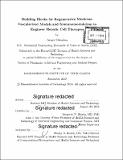Building blocks for regenerative medicine : vascularized models and immunomodulation to engineer hepatic cell therapies
Author(s)
Chhabra, Arnav.
Download1145279236-MIT.pdf (15.97Mb)
Other Contributors
Harvard--MIT Program in Health Sciences and Technology.
Advisor
Sangeeta N. Bhatia.
Terms of use
Metadata
Show full item recordAbstract
Despite significant advances in our knowledge about liver pathology and regeneration, non-palliative regimens for most end-stage liver disorders are limited. The only definitive treatment for end-stage liver failure is an orthotopic liver transplant. Unlike other major causes of mortality, death rates from liver diseases are rising instead of declining, leading to widening discrepancy between supply and demand of liver transplants. Thus, the development of an engineered liver construct is crucial to provide an alternative to whole organ transplantation or even for temporary support throughout medical intervention. The development of functional solid organ systems like the liver is an arduous task and faces many challenges. This thesis sought to address two of these challenges: hepatocyte (liver parenchymal cell) sourcing and immune compatibility. The main hurdle in primary human hepatocyte sourcing is the loss of regenerative potential of the cells ex vivo. In vivo, liver regeneration occurs as a well-orchestrated process. Although animal models have offered myriad insights into the process, the exact mechanisms and interactions in humans are less well understood. To this end, we developed a three-dimensional platform called SHEAR (structurally-vascularized hepatic ensembles for analyzing regeneration) to model multiple aspects of human liver regeneration. SHEAR enables precise hemodynamic alterations, and supports biochemical inputs such as cytokines and paracrine interactions with endothelial cells. We found that exposing the endothelium to fluid flow led to increased secretion of regeneration-associated factors. Stimulation with relevant cytokines not only amplified the secretory response, but also induced cell cycling of human hepatocytes within the device. By applying unsupervised machine learning techniques to scan the secretome in stimulated devices, we identified endothelial-derived mediators that can independently stimulate proliferation of human hepatocytes. Collectively, the data presented here underscore the importance of multicellular models that integrate tunable biochemical and fluid forces, and demonstrate that SHEAR devices can be used to discover and validate conditions that promote human liver regeneration. Limiting the allogeneic immune response is a major challenge in the implementation of cell-based therapies. To ameliorate this problem, we engineered an immune cloak around transplantable liver tissue by enabling trans-presentation of immune checkpoint pathways. This technology is called SHIELD (stealth hepatic immunotolerant ensembles for liver disease). SHIELD activates checkpoint pathways in supporting stromal cells and/or in endothelial cells lining the vasculature to induce immune cell exhaustion and anergy. These support cells are admixed with hepatocytes using tissue fabrication techniques and serve as the protector unit. SHIELD imparts inhibitory signals to immune cells surveying the graft, such that the graft does not get rejected by Human Leukocyte Antigen (HLA)-mismatched T cells. Thus, SHIELD provides localized, controllable immune-tolerance in a number of transplantation settings.
Description
Thesis: Ph. D. in Medical Engineering and Medical Physics, Harvard-MIT Program in Health Sciences and Technology, 2019 Cataloged from PDF version of thesis. Includes bibliographical references (pages 131-153).
Date issued
2019Department
Harvard--MIT Program in Health Sciences and Technology; Harvard University--MIT Division of Health Sciences and TechnologyPublisher
Massachusetts Institute of Technology
Keywords
Harvard--MIT Program in Health Sciences and Technology.